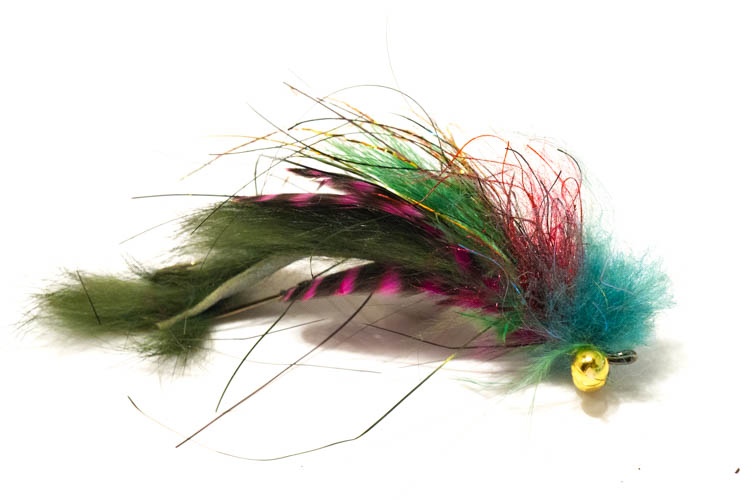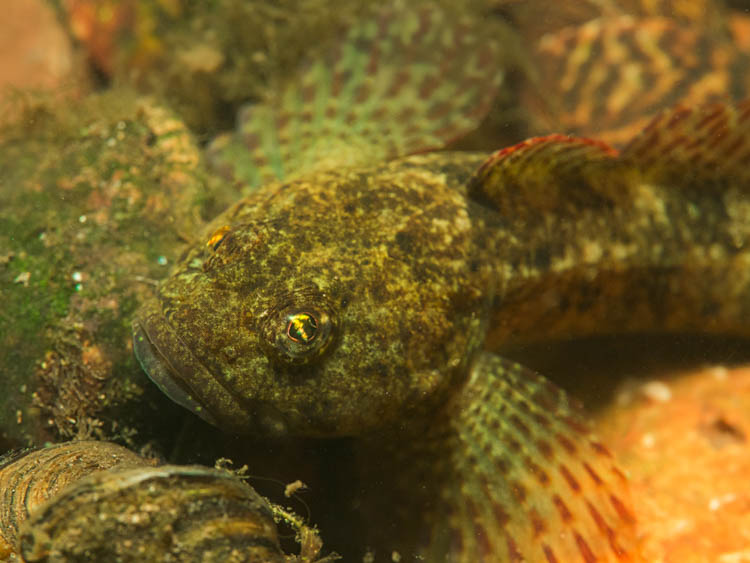Fly Pattern: The Grape and Green Sculpin

The grape and green sculpin is one of my favorite winter flies. Over many years, sculpins have always been a favorite for steelhead and large trout. This fly represents a continuous evolution in these patterns. One thing that I have learned about sculpins is that they take on the color of the bottom of the river and the fish can be picky about the color of the sculpin during the cold water periods of the year.
It is in the winter months that we have a lot of moss on the bottom of the river, and it becomes really pronounced during the late winter. This moss ranges from brown olive to blueish green. For that reason, a lot of sculpins take on a tint of olive, and the fish key on that color combination.
I fish this fly on the swing, but also as a slow strip/swing for the trout in the winter. It excels at both. If you plan on using the fly for stripping or swinging interchangeably, it is a good idea to either tie the fly on a hook vs a shank, or to tie the fly with a rabbit strip and pierce the strip with the trailing hook.

Here is the recipe for the Grape and Green Sculpin:
Shank: A long up eye shank, typically 50mm or more or a size 1/0 3XL hook such as Daiichi 2461
Loop (If using a shank): Braid or wire of your choice. Since I am typically tying this fly in large sizes, the trailing hooks are a little larger. Thus I lean toward heavy 80lb. braid on my own flies.
Eyes: Bead Chain, tied just behind the eye of hook/shank. These can be used for weight, or effect, or both. Sometimes I use heavy bead chain made of metal. Other times, when I don’t want the fly to sink as much, I use plastic gold bead chain.
Under-Tail: Two reddish or purplish grizzly hen feathers
Tail: Dark Olive Marabou, Rabbit Strip, Pine Squirrel, or Craft Fur
Wing: Two reddish or purplish grizzly hen feathers
Over-Wing: Dark Olive or Peacock marabou feather
Flash: Merlot flashabou, Avocado Flashabou, and a very little bit of yellow holographic flashabou.
Head: Small Tuft of Olive Australian Possum fur covered with a clumpy veil of moss blue Clyde dubbing or Olive Kraken Dubbing by Fly Tier’s Dungeon.
Pectoral Fins (Optional): Dark olive Marabou or rabbit strips and/or purple hen hackles, splayed.
Here are some tying instructions for the Toadbreaker sculpin:
- Cover the Shank with Thread.
- Tie in a pair of bead chain eyes at the front the hook.
- If you are using a shank: Tie in your loop. If you are using braid, it is recommended that you tie an overhand knot in it toward the tag end. This will keep the fly from self destructing if you get a violent strike. Make sure that you cover the whole shank with thread in the process. It is a good idea to add a drop of zap a gap or other quick drying glue at this point.
- Move to the very back of your shank or hook and tie in two purple hen feathers sloping over the very end of the fly.
- Move the thread forward, and tie in a clump or dark olive marabou or rabbit strip.
- Move the thread forward some more, and tie in a couple more purple hen hackles, sloping down.
- Lay a marabou feather on top of the hook.
- Add three colors of flash so that they extend to the length of the tail.
- Add a clump of Australian possum, and follow that with a rough clump of olive or moss colored dubbing.
- Tie in a clump of marabou just behind the eyes if you want pectoral fins.
- Add glue of your choice at the finishing point. I typically use some UV glue.
- Finish the fly.
If you enjoyed this sculpin pattern, or are seeking other flies that have been previous displayed here, please visit our patterns page. For a book that shows a lot about fishing baitfish patterns, check out Kevin Feenstra’s Matching Baitfish.
